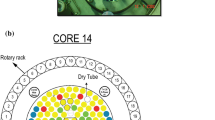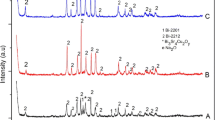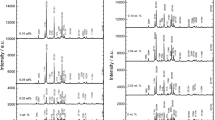Abstract
Neutron irradiation is one of the methods to improve the transport properties of superconductors by creating defects for flux pinning centers. In this work, the effects of fast neutron irradiation on (Bi1.6Pb0.4)Sr2Ca2Cu3O10 (Bi-2223) superconductor were studied. The samples were prepared using the co-precipitation technique and were exposed to fast neutron irradiation via pneumatic transfer system (PTS) with a neutron flux of 2.5 × 1012 n cm−2 s−1 from 60 to 660 s which are equivalent to neutron fluences of 1.55 × 1014 to 1.70 × 1015 n cm−2. The non-irradiated sample was dominantly Bi-2223 phase (85%) as shown by X-ray diffraction patterns. However, after irradiation, the volume fraction of the Bi-2223 was reduced and the (Bi1.6Pb0.4)Sr2CaCu2O8 (Bi-2212) phase increased, resulting in an almost 50:50 ratio of Bi-2223:Bi-2212. Energy-dispersive X-ray analysis indicated the presence of Zn and Po in some irradiated samples due to neutron activation. The onset transition temperature (Tc-onset) and zero transition temperature (Tc-zero) for the non-irradiated sample was 118 K and 105 K, respectively. The irradiated samples showed lower Tc-onset (112 to 115 K) and Tc-zero (100 to 104 K). AC susceptibility showed a transition temperature (Tcχ′) around 108 to 109 K. The imaginary part of the susceptibility showed intergranular loss peak temperature (Tp) from 89 to 96 K. Intermediate fluence of fast neutron irradiation did not affect the intergrain coupling and pinning strength of (Bi1.6Pb0.4)Sr2Ca2Cu3O10. However, higher fluence severely damaged the microstructure and degraded the flux pinning strength of (Bi1.6Pb0.4)Sr2Ca2Cu3O10.










Similar content being viewed by others
References
Ismail, M., Abd-Shukor, R., Hamadneh, I., Halim, S.A.: Transport current density of Ag-sheathed superconductor tapes using Bi-Sr-Ca-Cu-O powders prepared by the co-precipitation method. J. Mater. Sci. 39, 3517–3519 (2004)
Takada, J., Kitaguchi, H., Egi, T., Oda, K., Miura, Y., Mazaki, H., Ikeda, Y., Hiroi, Z., Takano, M., Tomii, Y.: Superconductor with Tc = 117 K in the Bi-Pb-Sr-Ca-Cu-O system. Phys. C 170, 249–253 (1990)
Lyuksyutov, I.F., Naugle, D.G.: Frozen flux superconductors. Mod. Phys. Lett. B 13, 491–497 (1999)
Gul, I.H., Amin, F., Abbasi, A.Z., Anis-ur-Rehman, M., Maqsood, A.: Effect of Ag2CO3 addition on the morphology and physical properties of Bi-based (2223) high-Tc superconductors. Phys. C 449, 139–147 (2006)
Mohd Suib, N.R., Abu Bakar, I.P., Ibrahim, N.B., Abd-Shukor, R.: Critical current density and AC susceptibility of Bi1.6Pb0.4Sr2Ca2Cu3O10 superconductor with Ni0.5Zn0.5Fe2O4 nanomaterial. J. Supercond. Nov. Magn. 32, 145–150 (2019)
Kong, W., Abd-Shukor, R.: Enhanced electrical transport properties of nano NiFe2O4-added (Bi1.6Pb0.4)Sr2Ca2Cu3O10 superconductor. J. Supercond. Nov. Magn. 23, 257–263 (2010)
Masnita, M.J., Awang, R., Abd-Shukor, R.: AC susceptibility and electrical properties of PbS added Bi. Sains Malaysiana 51, 315–328 (2022)
Roumié, M., Marhaba, S., Awad, R., Kork, M., Hassan, I., Mawassi, R.: Effect of Fe2O3 nano-oxide addition on the superconducting properties of the (Bi, Pb)-2223 phase. J. Supercond. Nov. Magn. 27, 143–153 (2014)
Agail, A., Abd-Shukor, R.: Effect of different nanosized NiO addition on Ag-sheathed (Bi1.6Pb0.4)Sr2Ca2Cu3O10 superconductor tapes. J. Supercond. Nov. Magn. 27, 1273–1277 (2014)
Pande, C.S.: Microstructural aspects of high and low Tc superconductors. Mater. Phys. Mech 2, 69–77 (2000)
Shitamichi, T., Nakano, M., Terai, T., Yamawaki, M., Hoshiya, T.: Activation of high-Tc superconductors due to neutron irradiation. Phys. C 392–396, 254–258 (2003)
Akamatsu, M., Ikeda, H., Yoshizaki, R., Iwaia, T.: Neutron and electron irradiation effects in Bi-2223. In: Y. Bando, H. Yamauchi (eds.) Advances in superconductivity V. pp. 439–442. Springer, Tokyo (1993)
Ossandon, J.G., Thompson, J.R., Kim, Y.C., Sun, Y.R., Christen, D.K., Chakoumakos, B.C.: Influence of neutron irradiation damage on the equilibrium properties of the polycrystalline Bi1.8Pb0.3Sr2Ca2Cu3O10 superconductor. Phys. Rev. B 51, 8551 (1995)
Aoki, T., Ueda, H., Ishiyama, A., Miyahara, N., Kashima, N., Nagaya, S.: Effect of neutron irradiation on high-temperature superconductors. IEEE Trans. Appl. Supercond. 21, 3200–3202 (2011)
Akamatsu, M., Yoshizaki, R., Iwata, T.: Flux pinning properties with neutron irradiation in Bi2223. Phys. B: Condens. Matter 194, 2195–2196 (1994)
Lee, S.H., Choi, Y.: Electromagnetic properties of Bi system superconductor for neutron irradiation. In: Proceedings of the Korean Powder Metallurgy Institute Conference, The Korean Powder Metallurgy Institute. 1239–1240 (2006)
Weigand, M., Eisterer, M., Giannini, E., Weber, H.W.: Mixed state properties of Bi2Sr2Ca2Cu3O10+δ single crystals before and after neutron irradiation. Phys. Rev. B 81, 014516 (2010)
Hu, Q.Y., Weber, H.W., Sauerzopf, F.M., Schulz, G.W., Schalk, R.M., Neumüller, H.W., Dou, S.X.: Enhancement of transport critical current densities in (Bi, Pb)2Sr2Ca2Cu3O10/Ag tapes at 77 K following fast neutron irradiation. Appl. Phys. Lett. 65, 3008–3010 (1994)
Chen, W.M., Jiang, S.S., Guo, Y.C., Jin, J.R., Wu, X.S., Wang, X.H., Jin, X., Xu, X.N., Yao, X.X., Dou, S.X.: Effects of low-energy neutron irradiation on Bi-based superconductors. Phys. C 299, 77–82 (1998)
Moss, S.D., Wang, W.G., Dou, S.X., Weinstein, R.: Uranium doping and neutron irradiation of Bi-2223 superconduction tapes for improved critical current density. INIS 29, 230–233 (1998)
Bean, C.P.: Magnetization of high-field superconductors. Rev. Mod. Phys. 36, 31–39 (1964)
Mohiju, Z.A., Mujaini, M., Hamid, N.A., Abdullah, Y.: Effect of neutron irradiation on microstructure and strength of Bi-2212 phase superconductor. J. Phys. Conf. Ser. 1123, 012010 (2018)
Ali, M.A., Jasim, K.A.: Studying the influence of fast neutron irradiation on properties of Bi2-xPbxSr2Ca2Cu3-yNiyO2n+4+δ superconducting system. Energy Procedia 157, 143–149 (2019)
Hannachi, E., Almessiere, M.A., Slimani, Y., Baykal, A., Ben Azzouz, F.: AC susceptibility investigation of YBCO superconductor added by carbon nanotubes. J. Alloys Compd. 812, 152150 (2020)
Clem, J.R.: Granular and superconducting-glass properties of the high-temperature superconductors. Phys. C 153–155, 50–55 (1988)
Halim, S.A., Mohamed, S.B., Azhan, H., Khawaldeh, S.: Effect of Ba and Zn doping in Bi2Pb0.6Sr2Ca2Cu3Oδ superconductors using AC susceptibility measurements. J. Mater. Sci. 34, 2813–2819 (1999)
Chen, D.X., Mei, Y., Luo, H.L.: Critical-current density in sintered high-Tc (Bi, Pb)-Sr-Ca-Cu-Oxide. Phys. C 167, 317–323 (1990)
Çelebi, S.: Comparative AC susceptibility analysis on Bi–(Pb)–Sr–Ca–Cu–O high-Tc superconductors. Phys. C 316, 251–256 (1999)
Sedky, A., Youssif, M.I.: Correlation between superconducting volume fraction and critical current density in copper oxide superconducting systems. Phys. C 403, 297–303 (2004)
Funding
This study was funded by the Universiti Tenaga National (no. 202210021YCU) and the Ministry of Higher Education of Malaysia (no. FRGS/1/2020/STG07/UKM/01/1).
Author information
Authors and Affiliations
Contributions
MM prepared the samples, performed the electrical resistance and AC susceptibility measurements, analyzed the data, and wrote the initial draft of the paper. ABPI and MNK analyzed the XRD and SEM data. NAH, RA, and FSA verified the data analysis. MM, FMI, and AMJB performed the neutron irradiation experiments and data analysis. RAS designed the experiment and wrote the final version of the paper.
Corresponding author
Ethics declarations
Conflict of Interest
The authors declare no competing interests.
Additional information
Publisher's Note
Springer Nature remains neutral with regard to jurisdictional claims in published maps and institutional affiliations.
Rights and permissions
Springer Nature or its licensor (e.g. a society or other partner) holds exclusive rights to this article under a publishing agreement with the author(s) or other rightsholder(s); author self-archiving of the accepted manuscript version of this article is solely governed by the terms of such publishing agreement and applicable law.
About this article
Cite this article
Mujaini, M., Ilhamsyah, A.B.P., Muhammad-Najib, K. et al. Fast Neutron Irradiation Effects on (Bi1.6Pb0.4)Sr2Ca2Cu3O10 Superconductor Prepared Using Co-precipitation Technique. J Supercond Nov Magn 36, 101–110 (2023). https://doi.org/10.1007/s10948-022-06480-6
Received:
Accepted:
Published:
Issue Date:
DOI: https://doi.org/10.1007/s10948-022-06480-6




